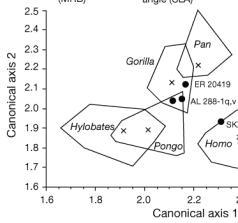Here were are, part 4 of my response to Answers in Genesis “rebuttal” of my post criticising their depiction of the famous Lucy specimen as a 4 legged knuckle walker (links to part 1, 2 and 3). Bored of these responses yet? Don’t worry, this will only be a short one given that AiG only offer a couple of paragraphs in response to my claim that there is no evidence of knuckle walking adaptations in the wrist of Australopithecus afarensis. In fact their response is so short I can quote it in its entirety
Evolutionists have, however, found such evidence for knuckle-walking. A more recent study by evolutionists Richmond and Strait confirms Lucy’s bones do have the features required to lock the wrist for knuckle-walking.23 Incidentally, this particular study is one of several plainly referenced in the Creation Museum’s Lucy exhibit.
The paper they cite on their display is Richmond & Straight’s “Evidence that humans evolved from a knuckle-walking ancestor,” published in Nature all the way back in the year 2000. The researchers argue that humans’ and chimps’ last common ancestor was a knuckle walker, as evidenced by the fact that Australopithecus afarensis (Lucy) and their close relative Australopithecus anamensis retain some archaic knuckle walking adaptations in their radius from this hypothesised ancestor.

The statistical analysis of Lucy (AL 288) showing it clusters with gorillas and orangutans
However, when analysing Au. anamensis Richmond & Straight failed to take into account a missing styloid process on the specimen’s radius. This naturally altered the measurements, rendering their conclusion regarding that species invalid. Conversely, their analysis of Lucy contained no such obvious errors but did reveal that her radius was similar to both gorillas and orang-utans. Given that the former don’t knuckle walk this raises the question of whether the “knuckle walking traits” Richmond & Straight identified are actually linked with knuckle walking.
Indeed, none of the purported knuckle walking traits identified in these hominins are actually linked to knuckle walking. For example, they claim fusion of two hand bones – the os centrale and scaphoid – discovered in these hominins is “an adaptation to resist weight-bearing stresses and improve the stability of the hand in terrestrial quadrupedalism.” However, subsequent research noted that there is no “direct biomechanical or kinematic evidence to support this hypothesis.“ Similarly, they claim that there is evidence of a dorsal ridge in the radius which the “indicate[s] that wrist extension was limited in these hominids as in knuckle-walkers” yet other research reveals “the significance of the dorsal ridge limiting extension in knuckle-walkers has yet to be demonstrated.”
Curiously, although Answers in Genesis are careful to note how the Richmond & Strait research is “more recent” than the study I originally cited they make no reference to the even more recent research critical of their paper. Indeed, in the late 2000s multiple criticisms of the knuckle walking hypothesis were published, many of them specifically criticising Richmond & Strait’s work. These critiques have been so devestating that few subsequent papers have referenced the knuckle walking hypothese (or Richmond & Strait’s work) favourably. Coincidentally, Answers in Genesis only cite one non-creationist article from 2006 onwards.
The story gets even worse for AiG since the original Nature paper doesn’t even claim what they think it claims. Richmond & Strait were arguing that humans’ and chimps’ last common ancestor was a knuckle walker and that hominins retained some traits associated with that behavior. However, they note that these hominins, such as Lucy, did not retain all of these knuckle walking traits and so could not have been habitual knuckle walkers.
…early hominids lack other distinctive knuckle-walking features, such as pronounced dorsal metacarpal ridges, and dorsally expanded and widened articular surfaces of the metacarpal heads, that increase the stability and range of extension in metacarpophalangeal joints…. The absence of these features in early hominids, in conjunction with clearly derived morphological evidence for bipedalism, suggests to us that early hominids did not themselves practice knuckle-walking.
Remember folks, this is one of the studies they “plainly reference” in their museum to justify their interpretation of Lucy. It identifies knuckle walking traits which aren’t actually associated with knuckle walking, fails to realize a bone being examined is broken, has been almost unanimously rejected by the scientific community and doesn’t even conclude that Lucy was a knuckle walker. Further research has revealed that there’s no evidence our ancestors were adapted to knuckle walking and so I feel safe in concluding I was right the first time.

